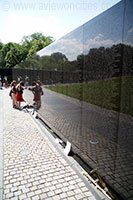Helping a Nation Heal.

Vietnam War Memorial (Photo courtesy of http://www.aviewoncities.com)
The black stone was smooth and cool against my fingertips, despite the warmth of that sunny September afternoon in Washington, DC. It was 2005, and my second encounter with the Vietnam War Memorial, but the impact of the experience was no less of a WOW than the first.
I randomly traced unfamiliar names with the index finger of my left hand – my Braille reading finger – and let the memories flood back from decades past.
It was 1968, and I was a senior in High School. Although the U.S boarder was only a couple of hours from Montreal, the Vietnam War, for most of us teens was little more than a blip on the evening news.
Then, one of my classmates told me about the “Sea Tiger”, a newspaper distributed to U.S. Marines in Vietnam, and everything changed. I wrote to the paper and had my name and address published in the pen pal section.
The letters poured in to the point where I was bringing them to school and handing them out to classmates who were interested in writing to a U.S. Marine. Fortunately, my BFF and I had agreed to split the letters as they came in, and that helped.
Over the next few years, I received letters from boys – many not much older than I – that gave me a peek into what life was like for these kids. There were post cards written on the tops of ration boxes, glossy pictures of fresh-faced young men, smiling for the camera, and a picture of “Maria”, the mortar used by a boy who was afraid to send me his photo because he mistakenly assumed I would stop writing to him once I knew he was black.
Most of the correspondence discussed music, politics, ethnic foods and hobbies. It was as if most of my pen pals wanted a little “normal” in the midst of the hell into which they had been sent.
But then, some poured out their hearts about “Dear John” letters, while others told of the number of beers it took for them to start feeling good. Too many told of receiving Purple Heart medals, and the injuries that earned them those awards.
For a kid who had paid little attention to a conflict being waged thousands of miles away, the Vietnam War almost became an obsession. I would watch the national news reports from our cable channels from the U.S., and cringe at the weekly death tolls. Homework and studying for finals would be put off until every letter that had come in that day had been answered. Sometimes people who were against the war would berate me for supporting “murderers”. I tried to explain that giving these kids what little I could in the way of comfort had nothing to do with whether or not I supported the war. Unfortunately my words fell on deaf ears.
What happened to my many pen pals? Well, the letters tapered off until there were about a dozen left. Some continued to write after they got home, and I even had a couple of telephone calls. Finally, by the time I was in my sophomore year in college, I had lost touch with all of them.
Do some of the names on the Vietnam War Memorial belong to men with whom I had corresponded? I truly don’t know. Although there is a box in our attic containing all the letters and memorabilia from my pen pal period, the idea of taking a list of the names to Washington just didn’t occur to me. The truth is, I really don’t want to know.
“So,” you ask, “where are the usual smart-ass remarks and the historical facts?” Well, memories of a war that divided a nation and cost the lives of over 58,000 U.S. service personnel really doesn’t put me in the mood for being amusing. But, since you took this trip down memory lane with me, you are entitled to know more about the Vietnam War Memorial.
Inspired by the film, “The Dear Hunter”, Jan Scruggs, a wounded Vietnam vet, provided the many reasons for the formation of The Vietnam Veterans Memorial Fund, Inc., a non-profit organization charged with the establishment of a memorial to honor those who died in the Vietnam War. Nearly $8.5 million was raised for the project.
On November 13,1982, the completed memorial was dedicated. The designer, Maya Lin, came under fire from several sectors for the simplicity and color of the Memorial. Contributor, Ross Perot, was one of several who withdrew financial support shortly after Lin’s design was selected.
The Memorial consists of two slabs of black stone that was brought from India and cut and finished in Barre, Vermont.
Each panel is approximately 247 feet long, and is etched with the names of Americans lost in the Vietnam war. The two walls meet at a height of 10.1 feet, and are meant to represent a wound that has closed, but is still healing.
There is a path around the Memorial, and there are also podiums with directories where people can search out the locations of specific names.
The black stone is so highly polished that you can see your reflection superimposed on the names etched in the surface. I’ve heard it said that when it rains, the walls appear to be weeping. The sun was shining, so we didn’t witness this phenomenon, but it certainly would be fitting.
Having seen the memorial, and having lived through that turbulent period, albeit in another country, the Vietnam War Memorial is an appropriate tribute to the men and women for whom it was built. It’s stark simplicity, shiny black surface and all the tens of thousands of names put a catch in my throat when I say “WOW!”



